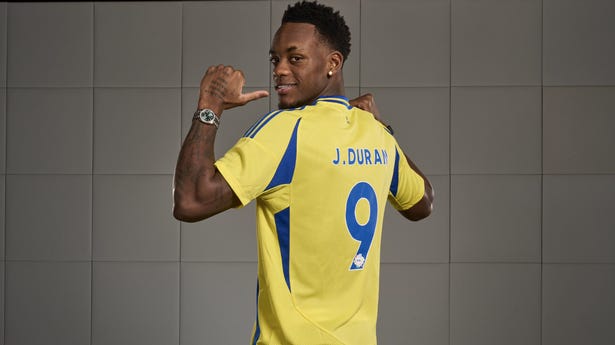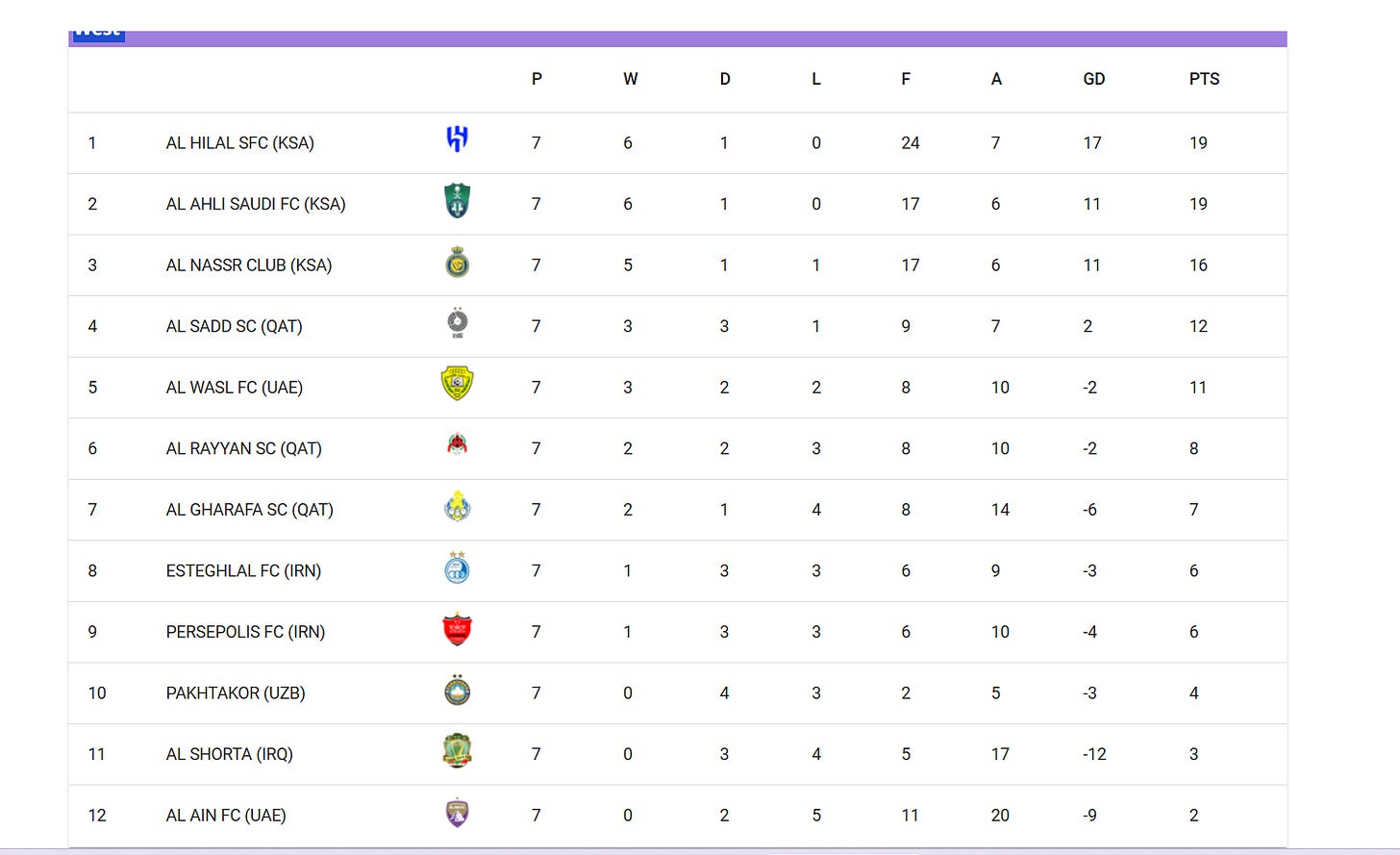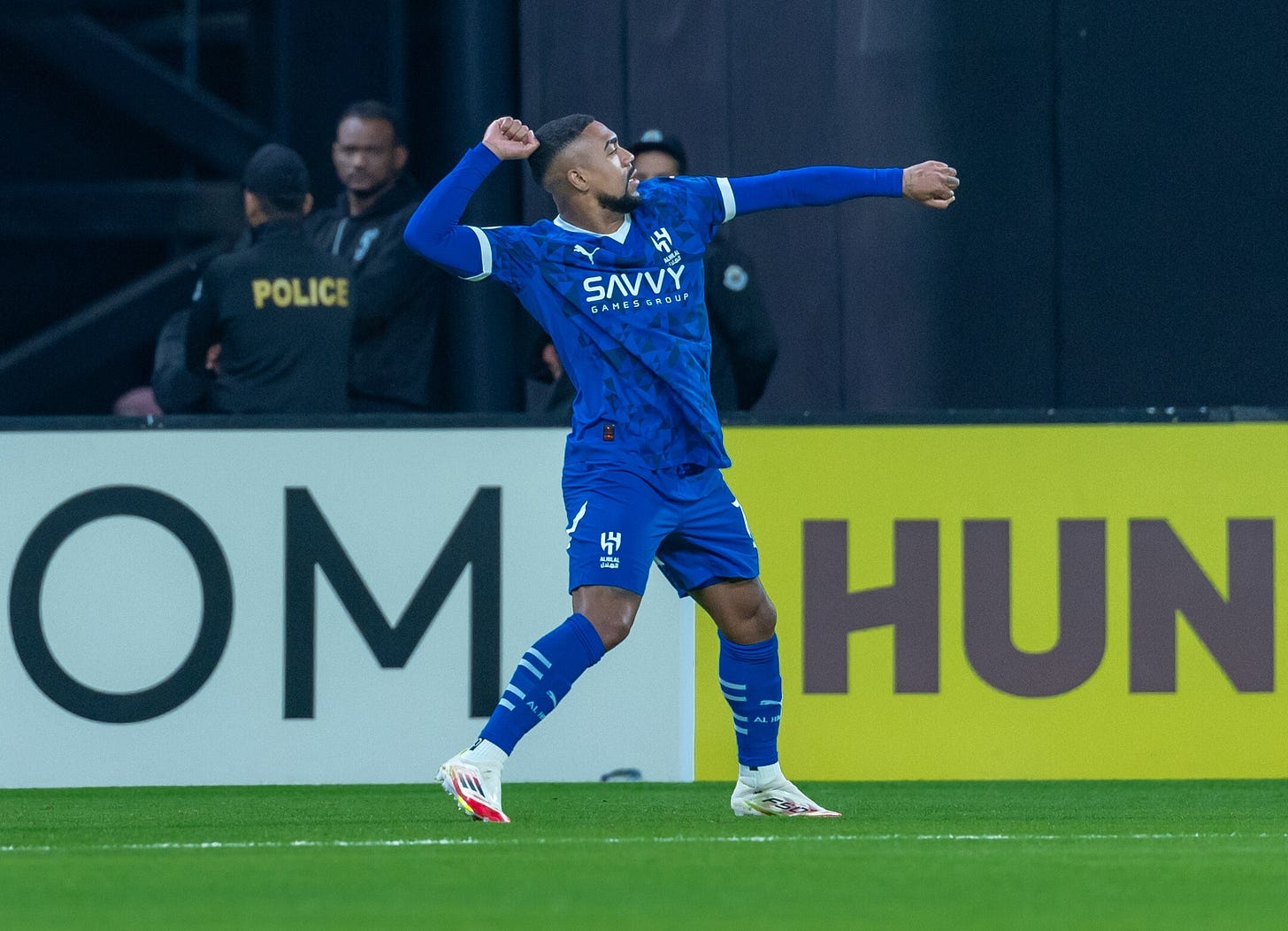The Saudi Arabian domination of the Asian Champions League
Proud old teams like Iran's Persepolis struggling to compete
The headlines this week in Asian football have been about Cristiano Ronaldo turning 40, him having a new big-money team-mate in Jhon Duran and other Saudi Arabian clubs being active in the transfer market just before the window closed.
Duran signed on Friday and then faced a race to be registered for Monday’s game in the AFC Champions League Elite. Usually the Asian Football Confederation (AFC) rules that five days are needed but this time, it was all waved through. After all, the debut of the biggest signing of the January transfer window for a reported fee of £64/€77/$79 million, was going to be big news.
On the pitch, he wasn’t really needed. In December, the three Saudi Pro League teams in the Champions League had already booked their places in the Round of 16 with two games of the group stage remaining (eight of the 12 teams in the West Asian group progress to the knockout rounds to join eight from the east). The action resumed on Monday but despite having little to play for Al-Ahli, Al-Hilal and Al-Nassr were all much to strong for their opponents.
On Monday Al-Ahli won 3-1 at the Qatari home of two-time continental champion Al-Sadd, with Ivan Toney and Riyad Mahrez adding to Roberto Firmino’s spectacular bicycle kick. Al-Nassr thrashed Al-Wasl (the club from Dubai that was coached by Diego Maradona for from January 2011 to July 2012) 4-0 with Ronaldo contributing two. Then on Tuesday Al-Hilal were 4-0 up against Persepolis before the break and took feet off pedals to beat the Iranians 4-1. Even with a game of the group stage left, the teams from Riyadh and Jeddah are going to finish first, second and third. After a combined 21 games, the trio have won 17, drawn three and lost just the one. It is quite the record.
Fallen Giants
A few years ago, a case could have been made for Persepolis being the biggest club in Asia. The Reds have millions of fans in Tehran, Iran and the diaspora around the world. Not only that, their home is the Azadi Stadium, as iconic as any on the continent. Yet, like that arena, Persepolis have seen better days and were completely outclassed.
There are bigger issues at play and not because there were a few absences on the night. Iranian club football has fallen by the wayside over the years due to mismanagement, a lack of investment at all levels, poor infrastruture, corruption and more besides. The opposite has been happening at the home of their regional rivals in Saudi Arabia and the fact is that Al-Hilal, already the most successful club in Asian club history with four championships, are now operating on a completely different level on and off the pitch.
Former Persepolis star Morteza Kermani Moghaddan summed it up for many of the club’s fans.
"Unfortunately, I saw this game and I was very sad. When I saw the stadium and their facilities, the first thing that came to my mind was why do they have such facilities and we don't? Where were they and where were we? We were humiliated in the first half. There was a huge gap between the two teams and this gap has become unattainable and is getting wider every day. I myself have played against Al-Hilal in Iran and we went to the final, but I was really sad that the gap between us and the Saudi teams has become so wide.”
During the game, fans watching back in Tehran were also unhappy that Turkish star Serdar Dursun seemingly asked when the score was 4-0 to ask Hilal’s Brazilian winger Malcom to swap shirts.
It was painful for a proud team that were Champions League finalists in 2018 and 2020. The fact is that no clubs in Asia can match the financial backing of the Public Investment Fund backed Saudi quartet (the three in Asia as well as Al-Ittihad) except perhaps for another club from the same league in Al-Qadsiah, owned by Saudi oil giant Aramco.
In the past 20 years or so, the leagues of the United Arab Emirates and Qatar have played host to some big names and produced some big teams but are increasingly playing second fiddle to its bigger neighbour. Last year Al-Ain of the UAE managed to knock out Al-Nassr and Al-Hilal before winning a second title but they have lost all three games against Saudi opposition this time. The Asian Football Confederation (AFC) is fairly relaxed about the prospect of Riyadh/Jeddah domination. For years the body has been trying to think of ways to promote the tournament around Asia but it turns out that having superstars like Cristiano Ronaldo, Riyad Mahrez, Ivan Toney and even Neymar occasionally, is a great way to make headlines, attract eyeballs and harvest clicks.
Some would see it as necessary to take the tournament to the next level. If there is to be a new period of Saudi domination then it at least gives the others something to aim for. It gives the tournament an easily understandable narrative around Asia and the world. On the pitch, for a while at least, there are worse things that could happen even to a tournament that has long been fairly open and competitive. It is up to the rest of the continent to try and find a way.
Rule Changes
The AFC does not, however, need to make it easier for Saudi Arabia’s clubs. In 2022, the AFC eased the restrictions on foreign players from ‘3 plus 1’ (the one is another Asian player) to ‘5 plus 1’. For this edition, there are no restrictions at all, a rule change that was advocated by the Saudi Arabia Football Federation and adopted by the continental body. This was why Neymar during the short period he was fit in October was able to play in Asia but not in Saudi Arabia, where there is a ten-player registration limit.
A bigger deal is that for this year and next year at least, all the games from the quarter-finals and onwards will be played in Saudi Arabia in one-legged clashes. Aside from the fact this deprives other fans of the chance to support their teams and the rest of the continent see different supporting cultures, it is a massive advantage. There was nothing wrong with the old home and way two-legged match-ups.
The likes of Al-Nassr, Al-Hilal and Al-Ahli don’t need the help, they are moving ahead as it is. At least there should be plenty of local interest when the tournament does reach the last eight stage and pitches up in Saudi Arabia though it remains to be seen what the rest of Asia makes of it.
John Duerden






